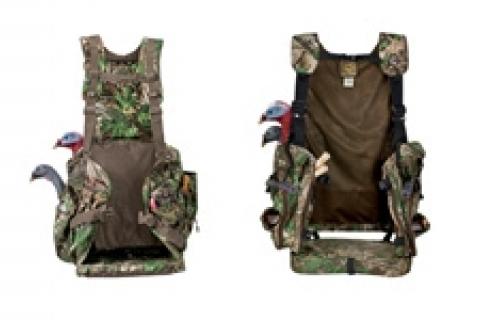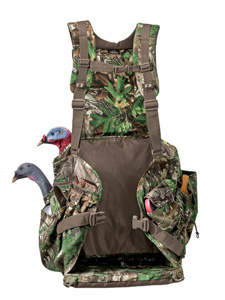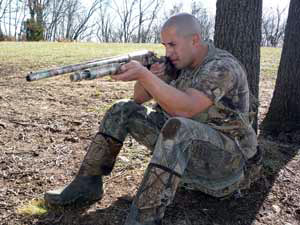
Turkey hunting is one of the most exciting and fastest growing forms of hunting today. Wild turkeys are hunted in 49 States and four Canadian Provinces. Many of these places offer both a spring and fall hunting season. Although there are differences in how turkeys are hunted in each season, one thing the two seasons have in common is the need for the hunter to be able to call in a turkey.
 |
| Turkey vests can help carry all kinds of items, such as calls, decoys, shells and a compass. |
This usually requires some type of calling device, and often more than one kind. In fact, most serious turkey hunters carry an assortment of turkey calls in the field in order to suit a variety of different situations that might be encountered. This usually leads to another thing that the spring and fall seasons have in common — the need for a good turkey vest to carry all those calls, and other essential gear, into the turkey woods. Here's what you need to know to make an informed choice when it comes to buying a turkey vest.
Turkey Vests Pockets
An abundance of assorted-sized pockets, both inside and outside the vest, is the biggest thing to look for in a turkey vest. If you use only one or two different calls, you may not see the need for so many pockets, but trust me when I say that as you get more involved in this thrilling sport, you'll be amazed at how many different calls and accessories you will collect over the years. And just as fishermen feel the need to lug their entire tackle box out on the water every day, even though they know they will likely only use a few different lures, you too will want to have it all with you in the field — "just in case." Personally, I think that you can never have too many pockets on a turkey vest. You will always find something to put in them, be it an extra sandwich for lunch, a cell phone, a GPS unit, etc.
But all pockets are not created equal, and large, single-compartment pockets can be downright annoying. Pockets need to not only store and carry your gear securely, but they need to also keep your gear, especially your calls, organized and accessible. Cavernous single pockets lead to fumbling and searching frantically for just the right call at critical times. Look for a vest that has both large pockets, for bulkier items such as binoculars, rangefinders or your lunch, as well as smaller pockets for smaller items, such as your different turkey calls, shotgun shells, compass, etc.
These pockets should have zippers, snaps, magnetic or Velcro closures. Which you prefer is largely a matter of personal taste. However, a nice feature to look for is elasticized pockets. This helps to keep items secure and prevents them from moving around and making noise. This not only allows you to move quietly through the woods, but also prevents friction calls such as box calls and slate calls from shifting and making inadvertent sounds that could spook a wary gobbler. Some vests accomplish the same thing by having drawstrings in the pockets.
Many vests have a mesh pocket for mouth (diaphragm) calls, which allows the calls to dry while not in use. These vests may also have a pocket specifically for storing a slate call, perhaps with dividers for different strikers. By having a separate pocket for each specific type of call, you never have to search through random pockets looking for just the right one.
 |
| Many turkey vests come with built-in fold-down padded seats such as the RedHead Buckick Creek Turkey Lounger. |
Turkey Vest Comfort
Besides being practical, a good turkey vest also needs to be comfortable. Unlike most outer garments, size is not usually an issue, as most turkey vests are oversized and "one size fits all." If you are buying a fitted vest, keep in mind the amount of clothing you will be wearing underneath, and allow for cool mornings, especially during the fall and in the northern states and Canada. Some versatile vests also feature zip-off sleeves which can be removed when the temperature climbs, while others allow the addition of a hydration bladder to make quenching your thirst easier than ever.
But comfort isn't only about fit, it's also about sit. If there's one thing that you will likely be doing a lot of, it's sitting. A wary gobbler responding to your calling can often take a long time to finally move into shooting range. During that time, the last thing you want to be doing is squirming and fidgeting because you're uncomfortable. That's why I believe that a built-in back pad is essential.
Most vests are made of a thin, light material, in order to keep you cool during mild temperatures, but that thin material does not provide much cushioning when leaning up against a tree, especially those with rough bark. A vest with a padded back will allow you to sit comfortably for hours.
Many vests also have a fold-down padded seat. If you don't want to carry a separate seat cushion or stool with you, a built-in seat pad is also essential for keeping your backside off the cold, hard, ground.
For safety reasons, it's wise to always sit with your back against a tree that's wider than your shoulders. But what if you suddenly stumble upon a flock of turkeys, or one spots you while you are standing out in the open, and there are no large trees around to sit against? No problem, if you have a turkey vest with an internal frame for back support. One of these vests will allow you to simply sit down wherever you are, no tree required (and they provide additional comfort and support when sitting against a small or crooked tree). Some of these vests also have an internal frame in the seat cushion, for further comfort and support.
Still in the area of comfort, some newer vests are equipped with adjustable gun cradles to help you hold your shotgun steady at your shoulder, while others sport recoil pads on the shoulders to ease the kick of magnum turkey loads when that big gobbler finally gives you a clear shot.
Camouflage Vests
When it comes to concealment, camouflage is mandatory. Wild turkeys have excellent visual acuity, as well as the ability to see color, meaning that head-to-toe camo is in order. All turkey vests are camouflaged, but care should be taken in selecting an appropriate camo pattern.
 |
| Orange flags built-in the vests are an important safety design of turkey vests. |
During the early spring, when new vegetation and leaves have not yet sprouted, a pattern with more brown and gray is more effective than one that is predominantly green. Same goes for the fall season. However, as the spring season progresses, especially in the South, a green-based pattern blends in much better. For this reason, and because most vests are priced between $25 and $150, some hunters wear different vests at different times of the year and in different locations.
Hunting Safety
Safety should always be a paramount consideration in all forms of hunting, and turkey hunting is no exception. In fact, a very dangerous situation can arise when attempting to carry your bird out of the woods following a successful hunt, especially in thick cover or on public land.
A dead turkey being carried over your back or at your side can seem to be alive and moving as it bounces along through heavy cover. When combined with the hunter's total camouflage, and his inability to see another hunter that may be hidden and camouflaged nearby, it's easy to see how disaster can strike. The key is to keep yourself easy to see at this point, with the help of your turkey vest.
Most turkey vests have a removable blaze orange safety flag on the back of the vest. By simply making sure this is visible as you are leaving the woods, whether you're carrying a turkey or not, other hunters should have no problem seeing you.
Another option is to make sure that the bird you are carrying is not visible at all. For this reason, most turkey vests also feature a large game bag in the back. These compartments are also great for carrying turkey decoys.
Next to your gun or bow and your turkey calls, a good turkey vest is perhaps the most important item a serious turkey hunter can own. A little knowledge of what to look for will help you choose the right vest for you.
- 9168 views

